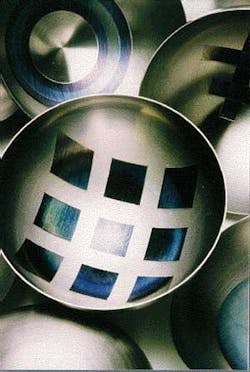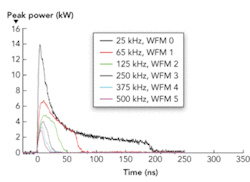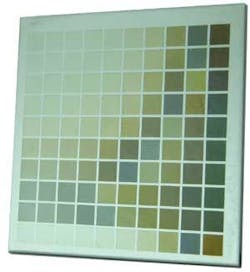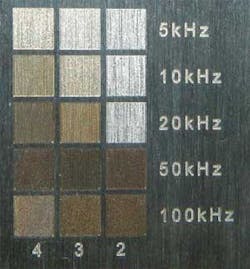Ornamental color laser marking of metals
Laser marking is rapidly becoming the dominant marking technology, finding its way onto nearly every product imaginable. Just empty your pockets and you will see your mobile phone, pen, and keyfob—all laser marked—even the buttons on your shirt. However, these are typically monochromatic marks that are functional and often lack something to give them more aesthetic appeal—namely, color.
The concept of using lasers to produce color marks on metals is not a new one. In fact, the cover of the January 1999 issue of Industrial Laser Solutions proudly displayed a picture of some niobium bowls that had been laser color marked by Ann Marie Carey, who established the viability of the technique for ornamentation of craft metal work and jewelry (see Fig. 1). Since then, there has been a growing interest in this application for product decoration. Manufacturers of consumer goods are looking for marking techniques that will make their products stand out, and color is a key potential differentiator.The generation of colored layers on metals was previously achieved using anodization, where the formation of carefully controlled, chemically produced oxide layers gives rise to a range of colors. The oxide layer behaves as an optical coating that acts as an interference film. When viewed, this gives rise to color that is dependant on the oxide thickness. The careful application of localized laser energy generates controlled oxide growth and, hence, color marks on the same principle as anodizing. This is supported by the fact that there is only a slight change in color when viewed at different angles.
In some instances, the surface morphology can impact the color. The roughness and residual lines generated by the marking process can affect the viewed color. If the lines are very precisely spaced, then a blaze grating effect can be achieved. This is evident if you view these marks perpendicular to the lines; tilting the sample gives a rainbow effect. Viewed parallel to the line, no such color variation is observed. A similar grating effect can be generated by using closely spaced spots, giving the effect in both orthogonal directions.
In achieving these colors the close control of heat input is essential. Nd:YAG and Nd:YVO4 lasers have been used for these applications at 1.06 μm as well as 2nd, 3rd, and 4th harmonics. The ability to operate the lasers at a broad range of frequencies, speeds, and power levels is essential to achieve optimal results.
The recent introduction of fiber lasers has provided the market with a new tool for this application, and the SPI Laser directly modulated pulsed fiber laser appears to be a versatile tool for generating color marks on metals. This laser can be operated from CW to 500-kHz pulse frequency; in this respect it is significantly more flexible than conventional Q-switched pulsed lasers and provides functionality beyond the current capabilities (see Fig. 2). The ability to utilize combinations of a wider range of pulse frequencies, pulse energies, and peak pulse powers in addition to average power and travel speed, focal position, and track overlap are significant process benefits for color-mark optimization and control.Materials that are known to be color markable include stainless steels, titanium, chrome plate, and niobium. Material grades and surface finishes can have an impact on the marking process, as can the thickness of the material. Brushed surfaces are more difficult to mark with a consistent color mark due to the magnitude of the roughness in terms of peak to trough being significantly larger than the depth of oxides being generated. Polished surfaces have been found to be far more consistent in terms of color.
As the color marking process is thermally driven, the material thickness can have a significant impact on the process. Thick materials provide a generous bulk heat-sinking capability, but thin materials can suffer from a number of thermal effects. Heat buildup can result in product distortion and progressive variation in color. For thin materials, careful control of heat input and heat-sinking need to be considered to optimize the results.Chrome-plated items also have been found to be receptive to color marking, and some tools are currently marked. However, at low pulse frequencies the color palette is very limited, with predominantly straw and golden colors. By increasing frequencies above 250 kHz a wide range of colors become available, opening new commercial possibilities. Applications where the color marks could be more functional do exist, for example, in bathroom fittings, where taps require both aesthetic and functional marks to indicate hot and cold water. This is currently done either in monochrome or with the use of colored plastic inserts, but could well be achieved by laser color marking.
The key is the uniquely high-repetition-rate capability for this type of laser at full laser power. No Q-switching means no Q-switch limitation. The unique structure of the fiber laser and direct modulation via pump diodes means that the full 20W average power of the laser is maintained all the way up to 500 kHz; there are no dead zones in the way that there are with some other competing laser technologies. At 500 kHz, 40 μJ is still available, and this has direct benefit to color marking as only low pulse energies and very high spot overlaps are required to allow multiple temperature excursions of each part of the substrate. In this way, surface oxides are enhanced and modified to produce the range of optical and surface chemistry effects that make up laser color marking.
Consider a fairly typical industrial marking laser employing a conventional, widely used 163-mm-focal-length lens and a relatively modest beam expansion of 3.7 times. With a 3.1-mm diameter beam and an M² of 1.8, a spot size of 30 μm is comfortably achieved. Typically, a low pulse energy of <100 μJ and a spot overlap of >90% is required to heat the surface to a high enough temperature for coloring effects to occur. The SPI Laser directly modulated MOPA laser can achieve the 80 μJ figure at 250 kHz.Another alternative is gray scale, which with stainless steel should perhaps more appropriately be referred to as brown scale marking. As an alternative to color marking under certain conditions the level of oxide on the surface can be controlled, giving an impressive range of shades of browns and golds (see Fig. 5). As with all marks, you are effectively altering the surface chemistry and surface morphology. In the majority of applications this is not a major concern, but in applications for harsh or sterile environments the effects of marks on corrosion resistance may need to be evaluated.
About the Author
Jack Gabzdyl
Industry Manager – Electronics, TRUMPF Laser UK Ltd
Dr. Jack Gabzdyl is Industry Manager – Electronics at TRUMPF Laser UK Ltd (Southampton, England) and has more than 30 years of laser materials processing experience. He obtained his PhD in laser processing from Imperial College London in 1989. He has since had a number of technical and marketing positions at BOC Gases, Advanced Laser Solutions, and TWI before joining TRUMPF (formerly SPI Lasers) in 2007.





